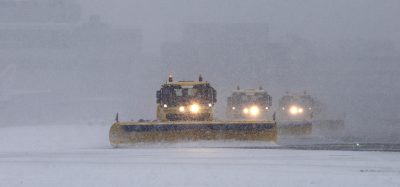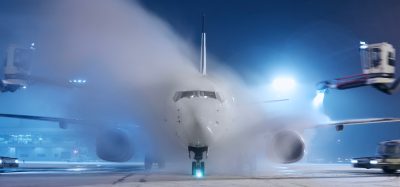A winter day at Zurich Airport
- Like
- Digg
- Del
- Tumblr
- VKontakte
- Buffer
- Love This
- Odnoklassniki
- Meneame
- Blogger
- Amazon
- Yahoo Mail
- Gmail
- AOL
- Newsvine
- HackerNews
- Evernote
- MySpace
- Mail.ru
- Viadeo
- Line
- Comments
- Yummly
- SMS
- Viber
- Telegram
- Subscribe
- Skype
- Facebook Messenger
- Kakao
- LiveJournal
- Yammer
- Edgar
- Fintel
- Mix
- Instapaper
- Copy Link
Posted: 16 July 2009 | Urs Haldimann, Deputy Head Airport Operations & Head De-icing Coordination, Unique (Flughafen Zurich AG) | No comments yet
During the mid-90’s, the planning of the new Midfield Terminal started and during the planning process the idea was born to create two de-icing pads, allowing a remote treatment of the aircraft, replacing the difficult to handle and more time consuming on-stand process. As a requirement for this so-called “fifth expansion phase” of the airport’s infrastructure, the authorities demanded the correct treatment of all the de-icing sewage, according to environmental rules, before the new facilities could be opened.
Time 06:32:15 – place: De-icing Coordination, Zurich Airport
“Good morning De-icing Coordination, Swiss 1248, we need De-icing, wings and stabiliser please” sounds the voice of the pilot of the early morning Zurich-Stockholm service over the VHF set in the De-icing Coordination Centre, on the roof of Terminal A at Zurich Airport.
“Good morning 1248, we take you in sequence for Remote De-icing”, answers Petra Doris Lonien, while noting down the flight details on the De-icing communication log before updating the airport information system with the respective code “RIC”, which stands for treatment on the “Remote De-icing Pad.”
From this moment onward, everybody involved, across the various organisations, stakeholders and systems dealing with this flight until take-off, will be aware of the fact that this Airbus A320 is going to be de-iced on one of the two Remote De-icing Pads available at Zurich Airport, before starting its journey to Scandinavia.
While Petra is more than busy handling the incessant requests for De-icing, let’s have a look at how winter operations are organised and managed at ZRH, where almost 7000 flights were de-iced during the Winter period 2008/2009.
Infrastructure De-icing
During the mid-90’s, the planning of the new Midfield Terminal started and during the planning process the idea was born to create two de-icing pads, allowing a remote treatment of the aircraft, replacing the difficult to handle and more time consuming on-stand process. As a requirement for this so-called “fifth expansion phase” of the airport’s infrastructure, the authorities demanded the correct treatment of all the de-icing sewage, according to environmental rules, before the new facilities could be opened.
During winter 2001/2002, the new De-icing pads (RDP) “Charlie” and “Foxtrot” were inaugurated. Each pad offers three De-icing Lanes. This allows the simultaneous treatment of two wide bodied aircraft or up to 3 Type C aircraft, which is A320 size. Two Beta-De-icing trucks are usually assigned to each aircraft to ensure a short process time. Last winter 71% of the traffic was handled via those remote pads.
For the replenishment of the trucks, two centrally located storage tanks direct de-icing fluid Type I, Type IV and hot water to filling stations next to the De-icing pads and remote refilling facilities used by Gamma trucks (for on-stand de-icing).
De-icing process
Until 2002 aircraft de-icing was controlled and handled by Swissair. After Swissair’s bankruptcy in April 2002, Zurich Airport took over the responsibility and the processes within the newly formed De-icing Coordination. Even though the lead is today with the airport, it is actually a product of a cooperation between airport, Swissport (Ground handler, physically carrying out the De-/Anti-icing), Swiss International Airlines (as hub carrier), Skyguide (Swiss air traffic control) and different service providers.
How does it work?
In close collaboration with the Swissport De-/Anti-icing unit, the Airport Steering, Zurich’s airport operations centre, is responsible for ensuring that the number of available de-icing trucks matches the possible demand for de-icing. Close contact to the meteorologist at the airport branch office of the Swiss Meteorological Office is a must to get a reliable weather forecast.
As soon as a decision about the level of service has been made, based on the weather forecast, Swissport, the provider of the de-icing, alerts its specialised staff, consisting mainly of regular staff volunteering to be on call during their off-duty time. At the latest, all trucks must be ready for operation one hour after the alert has gone out.
Beside the drivers for the Beta and Gamma trucks, each pad is staffed by a pad coordinator and for the assignment of the on-stand de-icing trucks a coordinator joins the Zurich Airport De-icing Coordination Centre, where the disposition of de-icing is performed. At full force, the de-icing fleet deployment consists of 10 Beta trucks for Remote De-icing and four Gamma trucks for On-Stand de-icing, Roland Meienberg, Head of Aircraft De-/Anti-icing, Swissport Zurich, said:
“In 2001, without any benchmark possibilities but in cooperation with all involved responsible parties, this unique treatment method, as one of the chain links within the departure sequence, has been pushed and introduced. Since then the Zurich de-icing has proved to be extremely efficient, delays have been reduced to a minimum with the result that gate as well as stand availability on the other hand has increased. Since start up not a single, even minor, safety relevant incident has occurred.”
As soon as all “ice-men” (as the driver-operators of the de-icing trucks are called), pad coordinators and the de-icing coordinator are in place, a briefing is held where the treatment methods, fluid concentrations, as well as safety relevant information, is discussed.
In the meantime Petra has filled the first page of the Communication Log, meaning 34 flights have called in requesting de-icing. Depending on the weather, more and more flights will call in during the morning to get the required service.
Zeus helps tracking the flights
One monitor at Petra’s workplace shows slowly moving aircraft symbols on a map of the airport, providing a live view of the actual traffic situation. Looking at the de-icing pads, one can see that two lanes are busy and an aircraft is taxiing currently into the third lane. The queue forming on the taxiway in front of pad Charlie is getting longer by the minute, as the peak of the outbound traffic approaches. It is the business monitoring system “Zeus” which, on an interactive display, provides this very helpful live oversight of the traffic situation, which includes the de-icing trucks. By simply moving the mouse pointer over the plane symbol, a pop-up balloon of information about the flight opens. The Pad Coordinator uses it for active lane management, as does the Swissport De-icing Coordinator when assigning the transponder equipped de-icing trucks, used for On-Stand de-icing, facilitating the planning and process observation.
During a phone conference the previous evening, the Duty Managers from Control Tower (ATC) and Airport Steering (Airport) decided, based on the forecasted light snow fall for the morning, to increase the taxi-out-time from the standard 12 to 30 minutes, to prevent missed take-off slots caused by de-icing delays. Starting with the lowest degree of de-icing, “De-icing-on-request” with only sporadic calls from departing flights, soon the next degree “General De-icing” has to be declared because light snowfall has set in and all departing flights request de-icing. This escalation triggers various changes to the parameters of Apron Control, Skyguide and Flow Control systems.
The next, highest escalation step would be a declaration of “CHAMAN”operation (“CHAotic situation MANagement”) to Eurocontrol’s Centralised Flow Management Unit (CFMU), responsible for an orderly managed traffic flow in Europe. As Zurich is considered a winter airport it has the possibility, whenever there is an exceptional snow situation, to waive departure slots issued as a consequence of traffic restrictions. This privilege however restricts the number of possible departures by about one third, to avoid traffic jams on departure routes, resulting in accepting 23 departures per hour without them having to respect any pre-assigned slot, except if it is a sensitive slotted flight captured by sensitive regulations defined by the CFMU. A clear advantage of CHAMAN is an undeterred departure after termination of the De-icing process and thus prevents “holdover time problems” (for safety reasons a deiced aircraft may not wait too long for take-off because after a certain time snow will start to accumulate on the wings again).
Jonas Wobmann, FMP Manager Zurich, Skyguide – Swiss Air Navigation Services Ltd said:
“The CHAMAN procedure proves to be very effective in case of exceptional snow situations. Of course it does not reduce the delay caused by the de-icing process, but does give the Apron and Tower Control the flexibility required to operate the airport at the best performance, even during such exceptional conditions.”
On days with heavy snowfall, numerous runway clearings and cleanings will negatively affect airport operations. On such days a special “Winterops Coordinator” will supervise and coordinate all activities and services connected with flight operations. The idea is to have a “birds-eye” view of the winter operation processes in order to guarantee a smooth operation. Decisions are taken in a CDM (Collaborative Decision Making) fashion, to ensure a high acceptance by involved and affected partners and to base decisions on as much information as possible.
On the De-icing Pad
Responsible for all aircraft movements on the ramp, Apron Control directs the flights to the assigned De-icing lane where, after brakes have been set by the flight crew, the Pad Coordinator takes over. In coordination with the flightdeck crew and the Beta truck drivers he gives the ok to start the de-icing process, after having informed the flightdeck crew about the details of the de-icing (relation of hot water vs. de-icing fluid) and the maximum possible holdover time. During the de-icing process the engines of the respective flight are kept running, to speed up the process once the de-icing has been completed. As soon as the trucks retreat to a safe position, the crew is informed about the completion of treatment and the latest acceptable take-off time (maximum hold-over time). After that the aircraft changes back to Apron Control and taxies out of the pad, while the trucks slowly move up again, ready to accept the next plane.
Depending on the quantity of the de-icing fluid necessary (this depends whether only frost has to be removed or whether the aircraft has snow on the fuselage and wings), the two single-driven trucks (there is only one person doing the driving and de-icing at the same time) will be able to handle an average of three to five aircraft before they have to refill their tanks (around 10’000 litres of liquid). This takes around 10 minutes.
Keeping the airport operational
Hours before the De-icing Coordinator starts on duty, the responsible Airport Manager, Marco Gerber, drives down Runway 14 in his yellow station car, carrying out one of his periodic runway checks and reports the state of the runway, including braking conditions, to the control tower. As the truck’s additional headlights beam into the dark night, the first snowflakes dance in the cone of the glaring light. It is a few minutes past three o’clock in the morning when the snowfall, predicted by the meteorologists, starts. Back in the office he calls up the Winter Services department, a unit of the airport’s Airfield Maintenance Department, which is responsible for snow clearing and the de-icing of slippery surfaces and tells them to get ready for snow clearing.
Winter Services will now alert the staff on the Pikett-list this morning of the three cleaning groups equipped with heavy duty snow removal equipment. Their duty is to clear and clean the extensive airport surfaces from snow and ice. The seven brand new Jetbrooms (plough, brush, blowing system), which can each clean an 8 metre wide strip in one go, start their run after having attended a detailed briefing by Airport Authority about the order in which the different surfaces have to be cleaned. Depending on predicted visual conditions, a landing runway has been assigned hours before the first landing.
As soon as flight operations start in the morning, all partners are informed about the general situation and planned next steps by means of a “Snow Committee telephone conference.” A Coordinator takes up his place in the control tower to supervise and coordinate all clearing activities, relaying requests for clearing to the cleaning forces and informing all involved services about the progress.
Hanspeter Moll, Head of Airfield Maintenance, Unique (Flughafen Zurich AG) said:
“The hub airport ZRH must be snow and ice free and kept open for our customers any time. ZRH was never closed in the last 60 years!”
When the first flights, mainly long haul aircraft from overseas, start their approach towards Zurich airport at six o’ clock in the morning, the runway is ready and clean, and has been checked again by Marco Gerber. The Control Tower can now inform the flight crews about runway and braking conditions and the first landings will take place a few minutes after six.
Environmental issues / De-icing sewage treatment
During winter service activities, the personnel in charge of the De-icing Sewage Treatment are also being challenged.
Markus Heusser, Head of Wastewater Treatment, Unique (Flughafen Zurich AG) said:
“In case of snowfall, or on a cold rainy day, some thousand cubic metres of storm water, contaminated with de-icing fluid in different concentrations, accumulate from the various operational surfaces. These are collected in basins, its concentration registered online as TOC (total organic carbon) and fed to treatment by a central control and supervision system.”
The concept has been developed in such a way that, depending on the origin of the sewage and the level of contamination, one of three treatment alternatives may be selected:
- Low contaminated de-icing sewage (DOC <20 mg/l, 55% of the water volume) is led through retention filter ponds. They consist of artificially built, flat and overgrown ponds in which the water slowly infiltrates. The main function is to retain large water volumes and drain them at a reduced rate (water retention).
- The medium contaminated fraction of the de-icing sewage (40% of the water volume) is irrigated through a spray system on suitable grassland at the airport. The waste water is cleaned in through the infiltration process. The decomposition of the substances occurs naturally by way of micro organisms in the top 60-90cm of the soil. The processes are mostly aerobic and the performance is 99.7%. The cleaned waste water is led through the drainage system into the Glatt river.
- De-icing sewage with a high content of carbon (DOC > 10,000 mg/l), which originates on the central de-icing pads, is swept up and collected separately and brought to a remote local sewage plant (plant Werdhölzli run by the city of Zurich). There it is used for sludge decomposition (production of biological gas). This fraction presents 75% of the amount of carbon, but only 5% of the amount of water.
- As a second possibility, Unique (Flughafen Zürich AG) has realised a concentration plant on the airport site in 2007 for the high contamination fraction. In this distillery plant, the concentration of the glycol is increased from 15% to 60-70%. The concentrate is then used by a specialised company and can be used for various purposes.
The quality of the degradation of de-icing sewage is monitored in the staff-managed laboratory.

















